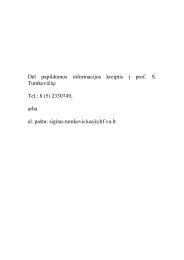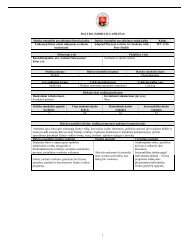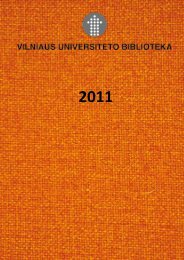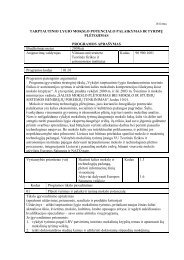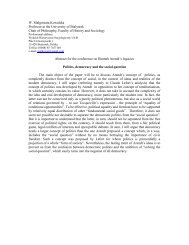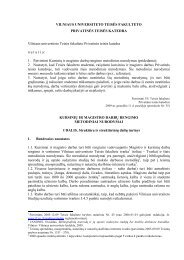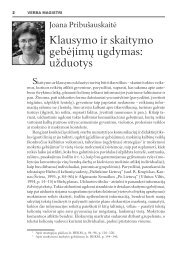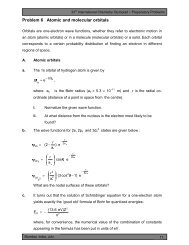Algebraic development of many-body perturbation theory in ...
Algebraic development of many-body perturbation theory in ...
Algebraic development of many-body perturbation theory in ...
- No tags were found...
Create successful ePaper yourself
Turn your PDF publications into a flip-book with our unique Google optimized e-Paper software.
4 Applications to the third-order MBPT 60(see Eq. (4.2)), etc. This is also true for the terms <strong>of</strong> effective Hamiltonian (see Eq. (4.3)):Ĥ (3) ∝ ̂V ̂Ω (2) ∝ ̂V 3 , etc. Each m–<strong>body</strong> part <strong>of</strong> <strong>perturbation</strong> ̂V (refer to Eqs. (2.40)-(2.43)) conta<strong>in</strong>s the m–<strong>body</strong> matrix element v m (α ¯β). Consequently, ̂Ω (k) conta<strong>in</strong>s the product<strong>of</strong> k such elements. Moreover, every s<strong>in</strong>gle term <strong>in</strong> ̂Ω (k) —obta<strong>in</strong>ed by us<strong>in</strong>g the Wick’stheorem—is evaluated separately. A typical example is the classical work <strong>of</strong> Ho et. al. [37].(The latter method <strong>of</strong> evaluation did not change until nowadays.) It should be obvious thatsuch <strong>in</strong>terpretation becomes tedious when a huge number <strong>of</strong> diagrams is generated. This factmakes sense especially for the higher-order PT. In the present case, on the other hand, thesolutions for ̂Ω (k) are given by Eq. (2.69) with a s<strong>in</strong>gle element ω (k) . Thus ω (k) representsthe product <strong>of</strong> k matrix elements <strong>of</strong> ̂V m with energy denom<strong>in</strong>ators <strong>in</strong>cluded. In other words,is the kth–order n–<strong>body</strong> effective matrix element that characterises the n–<strong>body</strong> part <strong>of</strong>the kth–order wave operator. In addition to the convenience <strong>of</strong> otherwise marked product<strong>of</strong> matrix elements v m , there is also an essential peculiarity: by Theorem 2.3.12, the terms<strong>of</strong> ̂Ω (k) are comb<strong>in</strong>ed <strong>in</strong> groups (refer to Eq. (2.69)) related to the different types (core, valence,excited) <strong>of</strong> s<strong>in</strong>gle-electron orbitals. That is, a number <strong>of</strong> Golstone diagrams drawn<strong>in</strong> ω (k) are characterised by the sole tensor structure and thus the problem <strong>of</strong> evaluation <strong>of</strong>each separate diagram is elim<strong>in</strong>ated. Meanwhile, <strong>in</strong> CC approach, the n–particle effects areembodied <strong>in</strong> the so-called amplitudes ρ n (see, for example, Ref. [42]) <strong>of</strong> excitation that are,ω (k)n<strong>in</strong> pr<strong>in</strong>cipal, the n–<strong>body</strong> effective matrix elements. Therefore, if replac<strong>in</strong>g ω n(k) with ρ n , thetensor structure <strong>of</strong> terms rema<strong>in</strong>s steady and thus such formulation is applicable to at leasttwo approaches <strong>of</strong> PT.2. In traditional MBPT, the two-particle matrix elements v 2 (α ¯β) or else g αβ ¯µ¯ν (see Eq. (3.53))are expressed <strong>in</strong> terms <strong>of</strong> b-coefficient (Sec. 3.2.1). In this case, as it will be confirmed later,a z-scheme is preferred.4.1 The treatment <strong>of</strong> terms <strong>of</strong> the second-order wave operatorThe generation <strong>of</strong> expansion terms <strong>of</strong> ̂Ω (2) is clearly a computational task and it is the most timeconsum<strong>in</strong>g process. The nowadays s<strong>of</strong>tware programs are capable to solve the problems <strong>of</strong> thepresent type. To generate the terms, the symbolic package NCoperators written on Mathematicais used. The features <strong>of</strong> the package are studied <strong>in</strong> a more detail <strong>in</strong> Appendix D, while <strong>in</strong> thepresent section, the study <strong>of</strong> already generated terms is argued.Despite <strong>of</strong> a large number <strong>of</strong> generated terms <strong>of</strong> ̂Ω (2) , fortunately, there are only a few <strong>of</strong>fundamental constructions that need to be considered: all the rest terms are obta<strong>in</strong>ed vary<strong>in</strong>gthe known expressions.In total, there are 13 such constructions (Tabs. 12-14). In tables, g αβ ¯µ¯ν and ˜g αβ ¯µ¯ν , the matrix representations<strong>of</strong> a two-particle <strong>in</strong>teraction operator g 12 , are def<strong>in</strong>ed by Eqs. (3.53)-(3.54). Theirexplicit expressions are found from Eqs. (3.63)-(3.64). For the typical <strong>in</strong>teraction operators g 12observed <strong>in</strong> atomic physics, the expressions <strong>of</strong> z coefficients are listed <strong>in</strong> the examples <strong>of</strong> Sec.3.2.1. Here, Remark 3.2.3 is taken <strong>in</strong>to account. The s<strong>in</strong>gle-particle matrix representation v α ¯β<strong>of</strong> the self-adjo<strong>in</strong>t <strong>in</strong>teraction operator v i reads (refer to Eq. (2.43))defv α ¯β = v ¯βα = 〈α|v i | ¯β〉 = (−1) λ ¯β +m ¯β f(τi λ α λ ¯β)〈λ α m α λ ¯β − m ¯β|τ i m i 〉, (4.5)f(τ i λ α λ ¯β) def= − [λ α] 1/2 [nα λ[τ i ] 1/2 α ‖v τ i]‖n ¯βλ ¯β . (4.6)In Eqs. (4.5)-(4.6), v τ idenotes the SO(3)–irreducible tensor operator that acts on the subspace<strong>of</strong> the space the operator v i acts on. It is assumed that the s<strong>in</strong>gle-particle Slater <strong>in</strong>tegral(s) is<strong>in</strong>volved <strong>in</strong> f(τ i λ α λ ¯β). The number <strong>of</strong> such <strong>in</strong>tegrals depends on the basis |n α λ α m α 〉. Thenumbers f(τ i λ α λ ¯β) are complex, <strong>in</strong> general, and they satisfyf(τ i λ ¯βλ α ) = o(τ i λ α λ ¯β)f(τ i λ α λ ¯β), (4.7)







